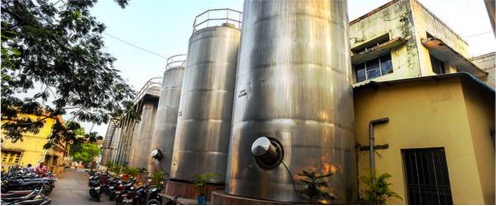Migration of farmers to urban areas and urbanisation have become major challenges for the dairy sector over the years, says S.V. Ramana, MD of Visakha Dairy
Since its inception in 1977 as a small dairy plant, Visakha Dairy has come a long way in becoming an industry leader and a household name, especially in the three North Andhra Districts.
It has grown leaps and bounds over the years from milk procurement of about 50,000 litres a day to 8 lakh litres, per day. From a customer base catering only to the employees in the Government sector, today, it has spread its reach to many states.
While its prominent presence is in Andhra Pradesh, Telangana, Odisha and Chhattisgarh, its premium products such as butter, tetra pack and good milk brands can be found in the remote corners of north and north-eastern India.
Farmer base
From a farmer base of about a few thousand, today Visakha Dairy has a milk farmer base of over 3 lakhs only from the erstwhile three districts of Visakhapatnam, Vizianagaram and Srikakulam.
The growth of the dairy was envisaged by its chairman Adari Tulasi Rao. Today, Visakha Dairy has over 1,600 permanent employees and over 100 chilling units spread across the three districts, with an average capacity of 10,000 litres, per unit.
Being a profitable entity in the cooperative sector is no easy task. Drawing inspiration from Verghese Kurien, the father of the white revolution in India and Chairman of Amul, Tulasi Rao since the beginning had focussed on developing the milk farmer base.
“Farmers should not be disturbed and we always stood by the farmers. Even during COVID -19 pandemic, when sales dropped drastically, as all hotels, restaurants, eateries and food kiosks were closed, we did not reduce the procurement to keep the farmers in profitability. Our supply was more than the demand and excess fresh milk was converted into powder” S.V. RamanaManaging Director of Visakha Dairy
The farmer base has always been our strength and this has given us the edge over the others, said S.V. Ramana, Managing Director of Visakha Dairy.
The success story of the dairy is scripted around this concept and a major part of the earnings to date is spent on the welfare of the farmers. “Farmers should not be disturbed and we always stood by the farmers. Even during COVID -19 pandemic, when sales dropped drastically, as all hotels, restaurants, eateries and food kiosks were closed, we did not reduce the procurement to keep the farmers in profitability. Our supply was more than the demand and excess fresh milk was converted into powder,” said Mr. Ramana.
From just fresh milk, Visakha Dairy’s product portfolio has expanded over the years from curds to sweets and from butter to different types of milks, which have longer shelf lives. Innovation has been the key for the dairy and almost all of its machinery is imported from Sweden.
Talking about the CSR for farmers, the MD said that Mr. Tulasi Rao has built a corporate hospital for the farmers and till date about 120 beds in the hospital are reserved for the dairy’s registered farmers, where they are given free treatment.
This apart, we have developed a veterinary service for the farmers. We have about 15 mobile clinics and about 30 veterinary doctors to cater to the needs of the livestock. These are apart from the loan facilities, ₹1 lakh ex gratia to the family when a farmer dies and education grants, he said.
Price rise mitigation
Accepting that the price of milk has risen by over 10% in recent times, Mr. Ramana said that there are a number of contributing factors.
As per him, the cost of livestock (buffalo) has gone up from ₹70,000 to ₹80,000 or even more and the cost of fodder has risen from ₹13 to ₹14 per kg to ₹20 to ₹22 per kg.
This apart, he says that rise in other costs such as power, coal, transport and fuel have all contributed to the rise in the milk selling price per litre.
“The price of coal had risen from ₹3,500 per tonne to ₹12,000 per at one point during the last two years. It is now down to around ₹8,000. All these have a spiralling impact on the selling price, but our goal is to keep it as marginal as possible, as milk is an essential commodity,” said Mr. Ramana.
Challenges for Dairy industry
The major challenge that the dairy industry is facing is migration and rapid urbanisation.
If farmers migrate from the villages to the cities for other means of livelihood, the industry would suffer, as it is directly linked to agriculture and farming. Similarly, rapid urbanisation is shrinking the farm lands, which is resulting in lesser lands for fodder.
Moreover, there is a trend that the present generation is not showing much interest in farming or dairy farming. This is a challenging phase and it needs to be arrested, he said.
To control the growing issue Visakha Dairy is planning to increase the productivity of livestock through artificial insemination. We have already started the process with the help of NDDB (National Dairy Development Board) and the idea is to inseminate local breeds with hybrid semen, so that productivity increases and farmers get better yield and profits, said Mr. Ramana.
Keeping the trend of migration and shrinkage of land, the dairy is focussing on establishing mini dairies, to keep control over the productivity.
(Graphic points)
Incepted in 1977 with a capacity of procurement of 50,000 litres- its procurement capacity has gone up to over 8 lakh litres per day.
The introduction of Mutually-aided Cooperative Society Act in 1999 was the turning point, when dairies started to function autonomously
Challenging factors
Migration of farmers to urban reaches
Urbanisation – leading to shrinking farm lands
Starting of mini dairies and increasing the productivity of animals can address the issue
Source : The Hindu 18th Nov 2022 by Sumit Bhattacharjee

